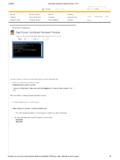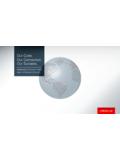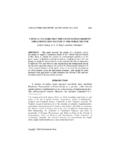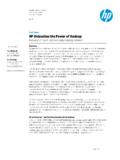Transcription of CLIENT TRANSPORT USING R3TRANS - Index page
1 Type Handbook Document Area SAP Basis Topic CLIENT TRANSPORT USING R3TRANS Author Huseyin Bilgen CLIENT TRANSPORT USING R3 TRANS V By Huseyin BILGEN All Rights Reserved. Copyright 2001-2002. Page 1 of 15 Type Handbook Document Area SAP Basis Topic CLIENT TRANSPORT USING R3TRANS Author Huseyin Bilgen Introduction In some special cases of SAP R/3 Projects, Production CLIENT may need to be transferred into Test System or Education System. This case means huge amount of data export from Production System. This can be problem, especially you are USING Oracle Database.
2 The CLIENT Copy tool allows you to copy selected components of an existing CLIENT to another CLIENT . The target CLIENT can either be in the same R/3 system or in another R/3 system. 1. Resource Requirements Copying clients requires a large amount of system resources. To avoid premature termination due to bottlenecks, you should ensure that enough resources are available by considering the following points: Database storage space For this purpose, we offer you to measure the amount of space allocated in database by source CLIENT via following programs: ZSTABSIZ ( Program for CLIENT Size Measurement in R/3 ) YSTABSIZ ( Program for CLIENT Size Measurement in R/3 ) YKSPACEC ( Program for CLIENT Size Measurement in R/3 ) If your target CLIENT newly constructed and empty, you must have enough space database.
3 This space information can be taken via above programs. If your target CLIENT is not empty, or nearly same size as source CLIENT ( eg. old version of source CLIENT , and you are refreshing it ) then you may not have to open space in target system as large as source CLIENT . Because during import process, R3TRANS replaces all data for target CLIENT with source CLIENT . File System storage space During export and import, you must have enogh free space under /usr/sap/trans file system if you are transporting USING tp program. No one can say how much space required for a CLIENT . But for an example we have exported 10 GB CLIENT and got total 3 GB export files.
4 This space is required both during export and import, for source and target systems. But if you are USING R3TRANS procedure, which will explained later in this document, then you must have a file system which have enough space. As you see you don t need to enlarge your /usr/sap/trans file system for CLIENT TRANSPORT . Temporary file system can be create and used for this purpose. Also you can use Tape Devices to export clients and import from Tape Device in target system. But this is another document and will be published soon. Runtime Copying a CLIENT can take several hours, and even users working in clients other than the source or target CLIENT can make the time longer.
5 For example, locks resulting from work being done in a third CLIENT in the same system can also obstruct the processing of individual objects. From a technical point of view, you can work in the system while CLIENT copy is running. However, you are strongly advised not to do this or do it in exceptional cases only. 2. Features When copying clients , you can select what you want to transfer from the source CLIENT to the target CLIENT : All Rights Reserved. Copyright 2001-2002. Page 2 of 15 Type Handbook Document Area SAP Basis Topic CLIENT TRANSPORT USING R3TRANS Author Huseyin Bilgen User masters: You select this option, for example, if you want to give all users of an existing CLIENT the same authorizations in the target CLIENT .
6 CLIENT -specific Customizing: You select this option, for example, if you want to set up a new CLIENT in an existing system. CLIENT -specific Customizing and master/transaction data: You select this option, for example, if you want to set up a test CLIENT that is identical to the production CLIENT (in the same system). CLIENT -specific and cross- CLIENT Customizing: You select this option, for example, if you want to set up a quality assurance system based on the production CLIENT of another system. CLIENT -specific and cross- CLIENT Customizing and master/transaction data: You select this option, for example, if you want to set up a test CLIENT based on the production CLIENT of another system.
7 The last two options are only applicable, if you copy clients between different systems. When the copy process is completed, the CLIENT copy tool automatically generates all ABAP Dictionary objects that were created as a result of a generation process. Normally, all CLIENT -specific data that has not been copied is deleted in the target CLIENT . 3. Cross- CLIENT Data Involved in Cross-System Copies and in Transports When cross- CLIENT tables are transported, inconsistencies may occur in the target system: Scenario 1: You have just installed the target system. The first step in setting up the clients involves importing a CLIENT from another system.
8 Since there are no other clients in the system yet, you can also copy the cross- CLIENT tables to ensure that all Customizing settings remain consistent, including those pointing to cross- CLIENT objects. Scenario 2: In the target system, you have set up clients whose data must not be affected. The cross- CLIENT data must not be imported into the system from outside, since the cross- CLIENT data overwrites existing data, so that the Customizing data of the other clients in the target system is no longer consistent. Only the data in the new CLIENT is consistent. This is why you should not TRANSPORT the cross- CLIENT data.
9 The data in the other clients of the target system is then still usable, and only the new CLIENT needs some postprocessing to reconcile the CLIENT -specific Customizing data copied with the cross- CLIENT Customizing data of the target system. 4. TRANSPORT Profiles For transporting clients , R/3 offers TRANSPORT profiles that make it easier for you to select and combine the components you want to TRANSPORT . SAP delivers the following TRANSPORT profiles: PROFILE DESCRIPTION SAP_ALL All CLIENT -specific data without change document SAP_APPL Customizing and application data SAP_CUST Copy Customizing data SAP_CUSV Customizing and report variants SAP_EXBC Customizing, users incl.
10 CLIENT -independent data SAP_EXPA Export all data incl. CLIENT -independent data SAP_EXPC Export Customizing including cross- CLIENT data SAP_RECO Recovery (only for source CLIENT = target CLIENT ) SAP_UAPP User master records, report variants, applic. data All Rights Reserved. Copyright 2001-2002. Page 3 of 15 Type Handbook Document Area SAP Basis Topic CLIENT TRANSPORT USING R3TRANS Author Huseyin Bilgen SAP_UCSV Customizing, variants, and user master records SAP_UCUS User master records and Customizing SAP_USER User master records and authorization profiles SAP_ALL is used to TRANSPORT all CLIENT specific data to target system.













